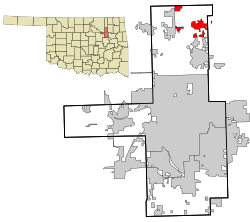Collinsville, Oklahoma facts for kids
Quick facts for kids
Collinsville, Oklahoma
|
|
|---|---|
| Nickname(s):
The Center of it All
|
|

Location of within Tulsa County, and the state of Oklahoma
|
|
| Country | United States |
| State | Oklahoma |
| Counties | Tulsa, Rogers |
| Settled | 1897 |
| Incorporated | 1899 |
| Government | |
| • Type | Council-manager city |
| Area | |
| • Total | 8.23 sq mi (21.32 km2) |
| • Land | 8.16 sq mi (21.13 km2) |
| • Water | 0.07 sq mi (0.19 km2) |
| Elevation | 676 ft (206 m) |
| Population
(2020)
|
|
| • Total | 7,881 |
| • Density | 966.05/sq mi (373.00/km2) |
| Time zone | UTC-6 (Central) |
| • Summer (DST) | UTC-5 (Central) |
| ZIP code |
74021
|
| Area code(s) | 539/918 |
| FIPS code | 40-16350 |
| GNIS feature ID | 2410195 |
Collinsville is a city in Oklahoma, USA. It is located in both Rogers and Tulsa counties. It is also part of the larger Tulsa Metropolitan Area. The city was named after Dr. A. H. Collins. He was an engineer and surveyor who first mapped the land here. In 2020, about 7,881 people lived in Collinsville. This was a big increase from earlier years.
Contents
History of Collinsville
How Collinsville Started
Dr. A. H. Collins helped start the community. He opened a post office here on May 28, 1897. At first, the place was just called Collins. By June 1898, its name officially became Collinsville. It became an official city in April 1899. In 1900, about 376 people lived there.
Railroad and Growth
A railroad line was built near Collinsville in 1899. It was part of the Atchison, Topeka and Santa Fe railway. An older community called Eli moved all its buildings closer to the new railroad. They moved the buildings on rollers in 1899 and 1900.
Changing Counties
Collinsville was first located in Rogers County. In 1918, people voted to join Tulsa County. This was because Tulsa was closer and had the county seat. Collinsville is only about 20 miles (32 km) north of Tulsa.
Early Industries and Changes
Collinsville had a lot of coal near the surface. This brought many miners to the area. About 1,500 to 2,000 miners worked here. Oil and gas production also grew for a while. There was also a zinc smelting business. The city's population grew to about 8,000 people. But these businesses did not last. By 1930, the population dropped to 2,249.
Farming and Dairy Capital
Since the 1920s, farming has been the main business. Many dairy farms are in Collinsville. They deliver milk products to Tulsa. In 1948, Oklahoma State University called Collinsville "the Dairy Capital of Oklahoma."
Geography of Collinsville
Collinsville is about 20 miles (32 km) north of Tulsa. It is located between three rivers: the Caney River, Verdigris River, and Bird Creek. The city covers about 8.23 square miles (21.32 km2) in total. Most of this area is land. A small part is water.
People of Collinsville
Population Growth
In 2010, 5,606 people lived in Collinsville. By 2020, the population grew to 7,881. This shows the city is growing.
Community Life
Collinsville is home to many families. In 2010, there were 2,111 households. Many households had children under 18. The average household had about 2.55 people. The average family had about 3.02 people. The median age in the city was 35 years old.
Economy of Collinsville
From Mining to Agriculture
In its early years, Collinsville's economy depended on coal mining. But this industry slowed down in the 1920s. After that, farming became the most important business.
Dairy Farms
The Sallee Family Dairy started in 1912. They delivered milk locally by buggy. By 1926, they used trucks to deliver to Tulsa. In the 1930s, there was also a milk cooperative and a cheese factory.
Media in Collinsville
Local Newspapers
Collinsville has its own newspaper called the Collinsville Times Star. It started on May 11, 1899. It is the oldest newspaper in Tulsa County. It is also Collinsville's oldest business that has been open continuously. The paper comes out every Wednesday. News about Collinsville is also in the Owasso Reporter newspaper.
Community Website
Collinsville also has a community website called Cvilleok.com.
Film-Friendly City
Collinsville has been recognized as a "film-friendly" city. This means it's a good place for movies to be made. Several films have been made here. The city's downtown area is also becoming an Historic Preservation District. This will help keep its photogenic look.
See also
 In Spanish: Collinsville (Oklahoma) para niños
In Spanish: Collinsville (Oklahoma) para niños

